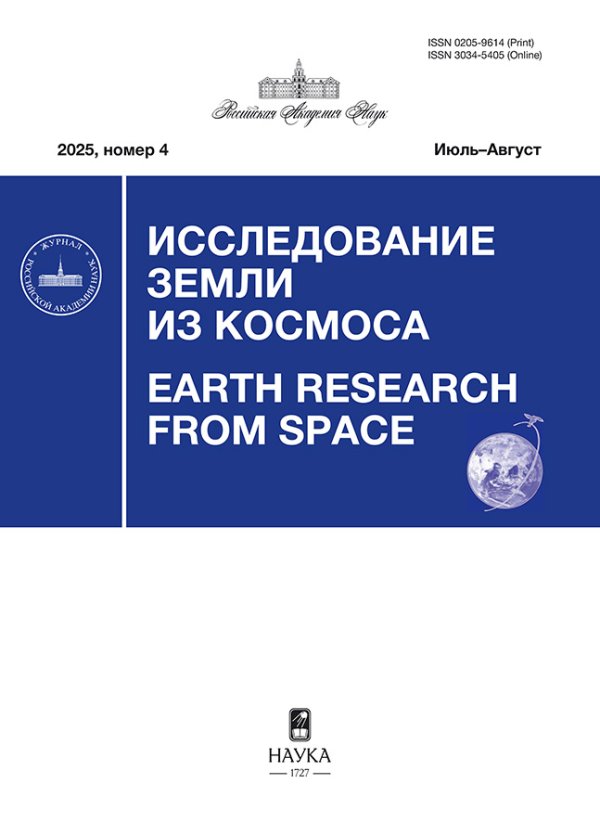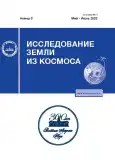No 3 (2023)
ИСПОЛЬЗОВАНИЕ КОСМИЧЕСКОЙ ИНФОРМАЦИИ О ЗЕМЛЕ
Anomalous Geodynamics before the 2023 Earthquake in Turkey According to Radar Interferometry 2018–2023
Abstract
Displacement velocity fields of the block-fault structure are constructed and the main geodynamic processes in the area of the East Anatolian fault are revealed based on the results of processing of 437 radar interferograms obtained from the Sentinel-1 radar in the period from the beginning of 2018 to disastrous seismic activity in February 2023 in Turkey by Stacking InSAR method. Anomalous block displacements along this fault have been identified, which are timed to the earthquake of January 24, 2020 (M = 6.7). Zones of stress-strain state of the main blocks in the period preceding the earthquake have been established using cluster analysis of time series of velocity fields. It is shown that the epicenters of February 2023 earthquakes are located in these zones. It is concluded that it is necessary to use such a technique to assess the stress-strain state in order to predict seismic activity.
 3-12
3-12


Registration Peculiarities of Wind Waves Breaking From Unmanned Aerial Vehicles
Abstract
The results of using an unmanned aerial vehicle (UAV) to study the processes of gravitational wave breaking are presented. The experiments were carried out in the coastal zone of the western Crimea (the area of Sevastopol) in the range of wind speeds from 5.5 to 9.5 m/s. The determination of the geometric dimensions of breaking and their speeds was carried out according to video recordings of sea surface obtained from the UAV. It is shown that the spatial resolution of the transformed image plays a key role in separating the active phase of breaking and residual foam. Errors occur in determining the kinematic properties of the breaking with a rough spatial resolution. The proportion of the sea surface covered with foam of breaking waves, the ratio of the maximum length of the spume to the length of the breaking wave, the distribution of the total breaking length in the intervals of movement speeds per surface unit (obtained from UAVs with a spatial resolution better than 0.5 m) are in agreement with results of other authors. Data analysis shows that the use of unmanned aerial vehicles makes it possible to study the statistical characteristics and kinematics of wind wave breaking. At the same time, it is necessary to take into account the effect of spatial resolution in the video frame, which can lead to distortion or omission of measurement data at values comparable to or exceeding the breaking scale.
 13-26
13-26


Evaluation of the NDVI Index as a Source of Information on Aboveground Phytomass in Steppes
Abstract
The complexity of phytomass measurements on sample plots hinders the extrapolation of plot-related data to areas comparable to land use or landscape units. Vegetation indices calculated from satellite images are usually considered as indicators of green phytomass and are used for its areal estimates. The study solves the problem of establishing the information content of the normalized difference vegetation index NDVI depending on the fractional structure of living and dead aboveground phytomass, seasonal dynamics of the biological cycle, hydrothermal conditions and landscape position. We used the results of monthly measurements of aboveground phytomass fractions at 13 sites covered by Stipa zalesskii and Stipa lessingiana formations in the Burtinskaya steppe (Orenburgsky nature reserve) from May to September in 2015–2020. For each period, NDVI values were calculated from Landsat satellite images at all sites. Hypotheses about geobotanical, hydrothermal, phenological and landscape factors of NDVI informativity were tested by using the Spearman correlation coefficients, analysis of variance and multiple regression. The discrepancy between the seasonal peaks of NDVI and green phytomass is not consistent with the common opinion of a direct indicator value of NDVI. The total live biomass correlates more clearly with the index in June and July but weaker at the end of the season. NDVI turned out to be sensitive not so much to green phytomass as such, but to the mass and proportion of forbs and the ratio of live and dead phytomass. In late spring and early summer, NDVI is most closely associated with forbs while in July – with grasses. The hypothesis about the possibility of screening green mass with standing dead biomass was confirmed, which leads to a decrease in NDVI despite the absence of a decrease in green phytomass. NDVI may underestimate the real green phytomass if there is a sharp increase in the mass of dead biomass, usually in the second half of summer and early autumn. NDVI more adequately reflects the state of the aboveground phytomass of steppe communities that have not been exposed to fires for a long time, compared to burned communities and fallows.
 27-43
27-43


Analysis of Anthropogenic Influence on Desertification Processes in the Northern Caspian Region According to Satellite Data
Abstract
Pasture loads are one of the key anthropogenic factors in the dynamics of the state of vegetation and soil cover of arid landscapes. The purpose of this study is to establish the spatial distribution of pasture loads in the Black Lands region using remote sensing data from space, geoinformation technologies and statistical data. In this work, mapping of livestock farms, sheepfolds and other places of concentration of livestock for 1984–1986 and 2020 was carried out. Both periods are characterized by a surge in desertification processes and a sharp increase in the areas of open sands and deflated lands. The areas of pastures with different loads during cattle grazing are established, the patterns of spatial distribution of mobile sands depending on the soil-forming rocks and distance from livestock farms are also determined. In recent years, compared with 1984–1986, the density of farms on sandy soils has increased, which led to overgrazing, destruction of vegetation and activation of Aeolian processes. Approximately 80% of pastures exceeded the permissible grazing standards, and 90% of pastures are located in a 3 km zone around the places of concentration of livestock. The results obtained can be used to regulate pasture loads in the region to prevent desertification of landscapes.
 44-57
44-57


МЕТОДЫ И СРЕДСТВА ОБРАБОТКИ И ИНТЕРПРЕТАЦИИ КОСМИЧЕСКОЙ ИНФОРМАЦИИ
Developing the Model of the Morphological Pattern for Thermokarst Plains with Fluvial Erosion Involving Remote Sensing Data
Abstract
The paper reports a new variant of the model of the morphological pattern for thermokarst plains with fluvial erosion involving numerous remote sensing data. This variant of the model takes into account different trends of the thermokarst processes for watershed plains and lowered bottoms of khasyreis (drained thermokarst lakes). The given model is tested at eight key sites located in different physiography, climate and geocryology. Testing was based on the high-resolution remote sensing data. The developed model is verified with a statistical analysis of lake area distributions within both watershed plain surface and lowered bottoms of khasyreis, demonstrating a state of dynamic balance in the course of emergence, growth and drainage of the thermokarst lakes. The analysis shows that the morphological pattern of the thermokarst plains with fluvial erosion changes evolutionarily, with reducing the area of the main watershed surface according to a dependence close to exponential; the specific type of the dependence results primarily from the ratio of the lake generation density and the location density of the fluvial sources.
 58-69
58-69


ФИЗИЧЕСКИЕ ОСНОВЫ ИССЛЕДОВАНИЯ ЗЕМЛИ ИЗ КОСМОСА
Retrieval of Cloud Liquid Water from MSU-GS Data On-Board Arctica-M No. 1
Abstract
The paper presents the method for cloud water path retrieval from daytime MSU-GS measurements on board the Russian hydrometeorological satellite Arktika-M No. 1. The presented technique based on the physical principles of the interaction of electromagnetic radiation with cloud particles at wavelengths of 0.55 and 4.0 μm. Cloud water path estimates obtained from the MSU-GS radiometer where compared with similar estimates from the AMSU/MHS and AHI radiometer data. Based on the results of the comparison, the required estimates of the cloud water path of drop clouds are within the permissible limits of the measurement error, not exceeding 50 g/m2. At the same time, due to its design features, the MSU-GS radiometer does not allow retrieving the cloud water path of ice clouds with the required accuracy. On average, the cloud water path estimate of ice clouds according to the MSU-GS data is underestimated by 110 g/m2, and the root-mean-square error is 158 g/m2 compared to the AHI radiometer data. The obtained estimates of the cloud water path introduced into the geographic information system Arktika-M, which provides access to the Arktika-M No. 1 data and the results of their thematic processing in a near real time mode.
 70-80
70-80


Dielectric Model of the Upper Organic Layer of Forest Soils for a Frequency of 435 MHz
Abstract
A single-frequency refractive dielectric model is proposed for thawed and frozen forest organic soils in the root zone at 435 MHz. The dielectric model was created on the basis of the laboratory dielectric measurements of four soils with organic matter content in the range from 15 to 31%. Dielectric measurements were carried out in the range of the gravimetric moisture from 0 to 0.6 g/g and temperature range from –30 to 25°С. The coefficient of determination (R2) between the predicted and measured values of the real (ε') and imaginary (ε") parts of the complex permittivity was 0.97. The normalized root-mean-square error was 16% and 21% for the real and imaginary parts of the complex permittivity, respectively. The created dielectric model may be applied in algorithms for remote sensing of forest soil moisture in the root zone using radar and radiometric data.
 81-96
81-96












